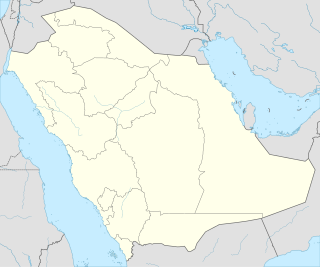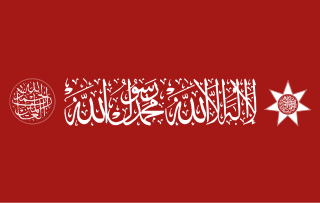
Mecca is the capital of Mecca Province in the Hejaz region of western Saudi Arabia and the holiest city in Islam. It is 70 km (43 mi) inland from Jeddah on the Red Sea, in a narrow valley 277 m (909 ft) above sea level. Its last recorded population was 2,385,509 in 2022. Its metropolitan population in 2022 is 2.4 million, making it the third-most populated city in Saudi Arabia after Riyadh and Jeddah. Around 44.5% of the population are Saudi citizens and around 55.5% are foreigners from other muslim countries. Pilgrims more than triple the population number every year during the Ḥajj pilgrimage, observed in the twelfth Hijri month of Dhūl-Ḥijjah. With over 10.8 million international visitors in 2023, Mecca was one 10 most visited cities in the world.

Transport in Saudi Arabia is facilitated through a relatively young system of roads, railways and seaways. Most of the network started construction after the discovery of oil in the Eastern Province in 1952, with the notable exception of Highway 40, which was built to connect the capital Riyadh to the economically productive Eastern Province, and later to the Islamic holy city of Mecca and the port city of Jeddah. With the economic growth of the 1970s, the Kingdom of Saudi Arabia has initiated many infrastructure development projects across the country, and the extensive development of the transportation network has followed suit in support of various economic developments.

Medina, officially Al-Madinah al-Munawwarah and also commonly simplified as Madīnah or Madinah, is the capital of Medina Province in the Hejaz region of western Saudi Arabia. One of the most sacred cities in Islam, the population as of 2022 is 1,411,599, making it the fifth-most populous city in the country. Around 58.5% of the population are Saudi citizens and 41.5% are foreigners. Located at the core of the Medina Province in the western reaches of the country, the city is distributed over 589 km2 (227 sq mi), of which 293 km2 (113 sq mi) constitutes the city's urban area, while the rest is occupied by the Hejaz Mountains, empty valleys, agricultural spaces and older dormant volcanoes.

The Hejaz is a region that includes the majority of the west coast of Saudi Arabia, covering the cities of Mecca, Medina, Jeddah, Tabuk, Yanbu, Taif and Baljurashi. It is thus known as the "Western Province", and it is bordered in the west by the Red Sea, in the north by Jordan, in the east by the Najd, and in the south by the Region of 'Asir. Its largest city is Jeddah, which is the second-largest city in Saudi Arabia, with Mecca and Medina, respectively, being the fourth- and fifth-largest cities in the country.

Taif is a city and governorate in the Mecca Province of Saudi Arabia. Located at an elevation of 1,879 m (6,165 ft) in the slopes of the Hijaz Mountains, which themselves are part of the Sarat Mountains, the city has a population of 563,282 people in 2022, making it one of the most populous city in the kingdom.

Jeddah, alternatively transliterated as Jedda, Jiddah or Jidda, is a port city in Makkah Province, Saudi Arabia, located along the Red Sea coast in the Hejaz region. Jeddah is the commercial center of the country. It is not known when Jeddah was founded, but Jeddah's prominence grew in 647 when the Caliph Uthman made it a travel hub serving Muslim travelers going to the holy city of Mecca for Islamic pilgrimage. Since those times, Jeddah has served as the gateway for millions of pilgrims who have arrived in Saudi Arabia, traditionally by sea and recently by air.

The Eastern Province, also known as the Eastern Region, is the easternmost of the 13 provinces of Saudi Arabia. It is the nation's largest province by area and the third most populous after the Riyadh and Mecca provinces. In 2017, the population was 4,900,325. Of these, 3,140,362 were Saudi citizens and 1,759,963 were foreign nationals The province accounts for 15.05% of the entire population of Saudi Arabia and is named for its geographical location relative to the rest of the kingdom.

The Provinces of Saudi Arabia, also known as Regions,, are the 13 first-level administrative divisions of the Kingdom of Saudi Arabia.
Al Lith is a city in the Tihamah region on the coast of the Red Sea south west of the holy city of Mecca. It is the fifth largest city in population in Makkah Province, and it is one of the large sea ports of the Kingdom of Saudi Arabia on the Red Sea, and Miqat Yalamlam is located north of it. The population of Al Lith is over 20,800 people.
Al Qunfudhah, also known as Kunfuda, is a Saudi city in the Tihamah region on the coast of the Red Sea. Its population is the fourth largest in Makkah Province, the area of the governate is estimated at 5,195 km², which occupies about 3.65% of the area of the region and is ranked ninth among the governorates of the region in terms of area. It is also one of the large sea ports of the Kingdom of Saudi Arabia on the Red Sea. Al Qunfudhah was founded in 1311 A.C-709 Hijri according to the ancient sources.

Rabigh is a city and governorate in the Province of Makkah of the Kingdom of Saudi Arabia, situated on the coast of the Red Sea, around 208 km (129 mi) northwest of Mecca in the historic Hejazi region. The city had an estimated population of 180,352 in 2014 and is situated at an elevation of 13 m (43 ft) above sea level, close to the border with the Madinah Province. The city dates back to the era before the advent of Islam in the 7th century C.E., and up to the 17th century, was known as Al-Juhfah, or Al-Johfah.

The Hijaz Mountains or "Hejaz Range" is a mountain range located in the Hejazi region of western Saudi Arabia. The range runs north and south along the eastern coast of the Red Sea, and can thus be treated as including the Midian Mountains, and being part of the Sarawat Mountains, broadly speaking.

Saudi Arabia is the second biggest tourist destination in the Middle East with over 16 million visiting in 2017. Although most tourism in Saudi Arabia still largely involves religious pilgrimages, there is growth in the leisure tourism sector. As the tourism sector has been largely boosted lately, the sector is expected to be the white oil for Saudi Arabia. This is proved as tourism sector is expected to generate $25 billion in 2019. Potential tourist areas include the Hijaz and Sarawat Mountains, Red Sea diving and a number of ancient ruins.

Thuwal is a coastal village in Jeddah Governorate, Makkah Province, Saudi Arabia, situated along the coast of Red Sea in the Hejaz region. Thuwal is 30 kilometres south of King Abdullah Economic City and 80 kilometres north of Jeddah.
The Battle of Mecca took place on 5 December 1924 in Mecca, as part of the Saudi conquest of the Kingdom of Hejaz by King Abdulaziz Ibn Saud of the Sultanate of Nejd. The Hejaz region was ruled as a kingdom under King Hussein bin Ali of the Hashemite family. The battle in Mecca resulted in a Hashemite defeat to the Saudis and the allied Ikhwan fighters.

The Riyadh Province, also known as the Riyadh Region, is a province of Saudi Arabia, located in the geographic center of the country and the center of the Arabian Peninsula. It has an area of 404,240 km2 (156,080 sq mi) and with a 2022 population of 8,591,748, it is the second-largest region by area, behind the Eastern Province and the largest by population. The capital governorate of the province is the Riyadh Governorate and it is named after the capital of the kingdom, Riyadh, which is the most populous city in the region and the kingdom, with a little less than two-thirds of the population of the region residing within the city. The province was governed for nearly five decades by Prince Salman bin Abdulaziz from 1963 to 2011 shortly before he became the Crown Prince in 2012. Currently, it is governed by Prince Faisal bin Bandar.

The Sharifate of Mecca or Emirate of Mecca was a state, non-sovereign for much of its existence, ruled by the Sharif of Mecca. A sharif is a descendant of Hasan ibn Ali, Muhammad's grandson. In Western sources, the prince of Mecca was known as Grand Sherif, but Arabs have always used the appellation "Emir".

The Vilayet of the Hejaz refers to the Hejaz region of Arabia when it was administered as a first-level province (vilayet) of the Ottoman Empire. At the beginning of the 20th century, it reportedly had an area of 96,500 square miles (250,000 km2). The Hejaz included all land from the southern border of the Vilayet of Syria, south of the city of Ma‛an, to the northern border of the Vilayet of Yemen, north of the city of Al Lith.

Highway 40 is a major east–west six-lane controlled-access highway in Saudi Arabia, spanning 1,395 km. The highway connects Jeddah, the second-largest city in the kingdom, on the western coast of Saudi Arabia to Dammam, the sixth-largest city on the eastern coast and the largest in the Eastern Province. Apart from Jeddah and Dammam, Highway 40 also runs near or through Mecca, Ta'if, Riyadh, Abqaiq and Khobar along its length, and provides access to the Mahazat as-Sayd and Saja and Umm Al Ramth wildlife sanctuaries.

Ahmadiyya is a persecuted branch of Islam in Saudi Arabia. Although there are many foreign workers and Saudi citizens belonging to the Ahmadiyya movement in Saudi Arabia, Ahmadis are officially banned from entering the country and from performing the pilgrimage to Mecca and Medina. This has led to criticisms from multiple human rights organizations.






















